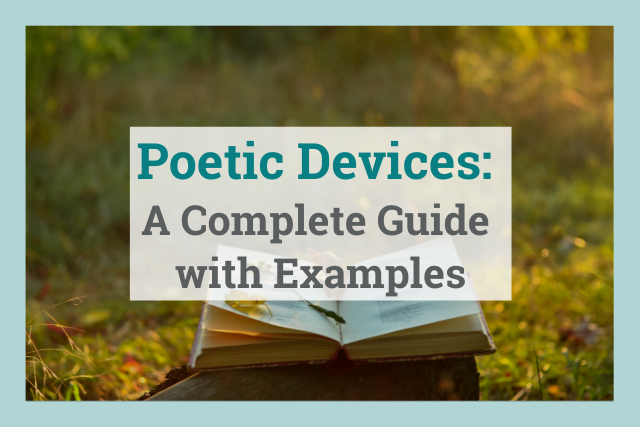
The term "poetic device" refers to anything used by a poet—including sounds, shapes, rhythms, phrases, and words—to enhance the literal meaning of their poem. This could mean using rhythm and sound to pull the reader into the world of the poem, or adding figurative meaning to their literal words.
How Many Poetic Devices Are There?
There are hundreds, possibly even thousands, of different literary devices open to poets, some of them very obscure having not been used for centuries, and so this article will divide them into categories—Poetic Form, Poetic Diction, and Poetic Punctuation—and concentrate on the most used poetic devices, with examples, in each category.
Poetic Devices—Form
First, we’ll look at poetic devices relating to form. Poetic form refers to how the poem is structured using stanzas, line length, rhyme, and rhythm. Clever use of poetic form can enhance the meaning or emotion the poet is trying to achieve.
What Are the Basic Poetic Devices of Form?
Again, there are a huge variety of formal choices open to a poet, but for the purposes of this article we can divide them into three categories: fixed verse, blank verse and free verse.
#1: Fixed Verse
Fixed verse poems follow traditional forms, based on formal rhyme schemes and specific patterns of stanza, refrain, and meter.
Types of fixed verse include limerick, haiku, ballad, villanelle, sestina, and rondeau. The most used, however, are odes and sonnets.
Odes
Odes are short, lyrical poems that are used to express emotions and praise. The Ode originated in ancient Greece as a way of praising an athletic victory, but later was adopted by the Romantics to convey emotion through intense or lofty language.
Odes vary in style and form but are nearly always formally structured. One of the most famous examples is Shelley’s Ode to the West Wind which is a poem written in iambic pentameter (combining an unstressed syllable followed by a stressed syllable in groups of five.) The poem praises the quality of the wind and is a strong invocation of the poet as bringer of political change:
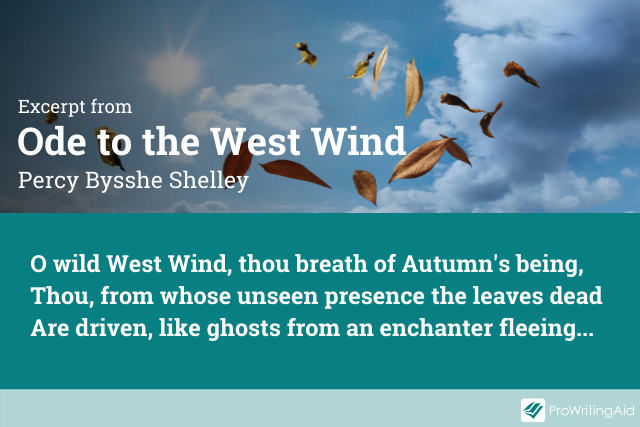
Sonnets
Perhaps the most famous type of fixed verse, the sonnet uses iambic pentameter in a fourteen-line poem, with a rhyme scheme of abab cdcd efef gg.
This fixed rhyme scheme can prompt unconventional phrasing, and gives the sonnet a sense of superiority over conventional speech, whilst at the same time the rhythm of the iambic pentameter keeps it feeling natural.
The sonnet has traditionally been used as a way of declaring love, most famously by Shakespeare in his 154-sonnet sequence that dramatized love, beauty, and the passing of time.
Whilst the most famous of these is Sonnet 18 ("Shall I compare thee to a summer’s day?") Sonnet 60, which examines the nature of passing time and its effect on human life, is worth looking at:
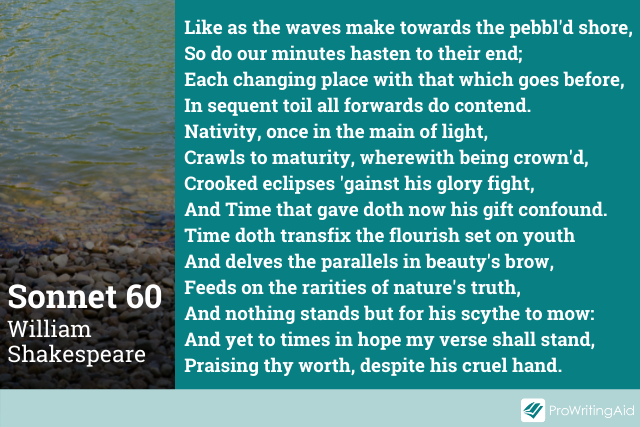
#2: Blank verse
Blank verse poems comprise unrhymed lines that use a regular meter—basically, a non-rhyming iambic pentameter.
Blank verse is the most influential of all English poetical forms and has regularly been used by all the great poets throughout the centuries.
Christopher Marlowe used blank verse first, but once again it was Shakespeare who made the form his own. The most famous example in Shakespeare’s work is the "to be, or not to be" soliloquy from Hamlet (although in this speech, he doesn’t stick religiously to the ten syllables of iambic pentameter).
Notice how the rhythm accentuates the feeling of grandness as all of life and death are considered:
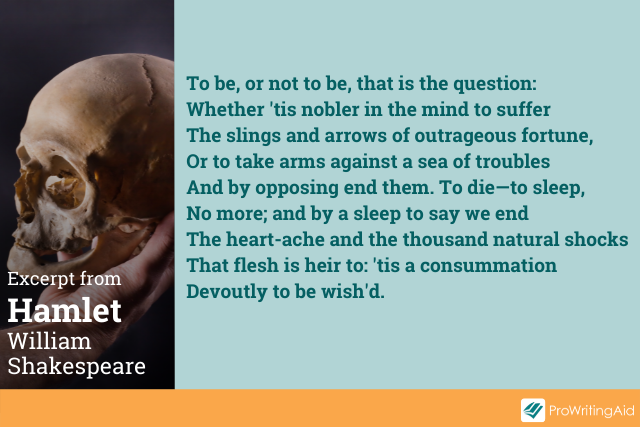
#3: Free Verse
Free verse poems remove the need for both formal rhyme and formal metric rhythm schemes. This allows the poem to be shaped completely by the poet. Removing this formality often allows the poet a far greater canvas on which to play.
A fantastic example of free verse poetry is the short, imagist poem This Is Just to Say by William Carlos Williams.

Poetic Devices—Diction
Next, we’ll look at devices of poetic diction. "Poetic diction" means the sounds, meanings, and rhythms that make up the language or "operating system" of poetry. These types of devices are what the poet uses to establish the feel and atmosphere of the poem.
Poetic Devices of Sound
These are poetic devices that use specific sonic effects to evoke emotions or thoughts, in the readers of the poem. The following examples represent some of the most common sonic literary devices in poetry:
#4. Alliteration
Alliteration is when two or more words start with the same consonant sound are used to emphasize an idea or action and create an emotional response.
A snake, slithering slyly, for example, enhances the sense of the snake’s deviousness and danger. Whereas if a poet uses p’s, d’s or b’s in a row, it gives their poem a strong, booming, drumbeat like sound:
Bore up his branching head: scarce from his mould
Behemoth, biggest born of earth, upheaved
His vastnessParadise Lost: The Seventh Book—John Milton
#5. Assonance
Whereas alliteration repeats the same consonant sounds at the start of words, assonance is repetition of vowel sounds (anywhere within the word) on the same or following lines of a poem to give a musical, internal rhyme. The sound will be a vowel sound, but doesn’t have to use a vowel, meaning you could rhyme some and mud, for example.
William Blake is well known for his use of assonance, such as the repeating “i” and “y” sounds in The Tyger:
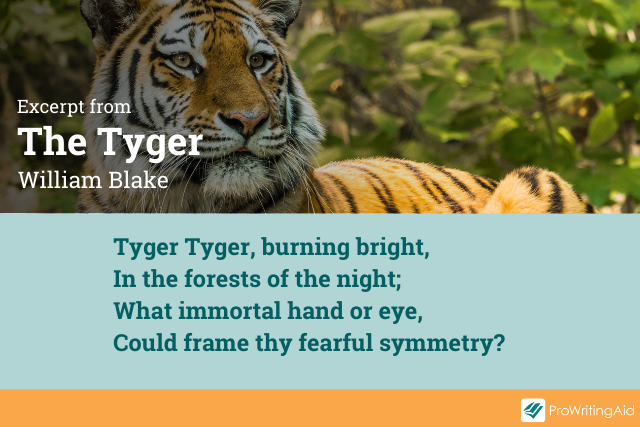
#6: Consonance
Consonance is a similar device to alliteration and assonance in that it involves repetition of sounds. But consonance consists of repeating consonant sounds at the end (and sometimes middle) rather than beginning of words.
Once again, we can look at The Tyger above, but this time considering the repeated “r” sounds in burning, bright, and forests. Similarly, the “t” sound is also repeated throughout, in night, bright, Tyger.
#7: Cacophony
Cacophony involves the use of unpleasant, nasty, or harsh sounds (mainly consonants) to give the impression of chaos, disorder or dread, as in Lewis Carroll’s poem Jabberwocky:
Beware the Jabberwock, my son!
The jaws that bite, the claws that catch!
Beware the Jubjub bird, and shun
The frumious Bandersnatch!
#8: Euphony
On the other hand, euphony is the repetition of harmonious, musical sounds that are pleasant to read or hear. This is achieved through the use of soft consonant sounds such as m, n, w, r, f, and h and through vibrating consonants such as s, sh, and th.
#9: Onomatopoeia
Onomatopoeia is a literary and poetic device wherein words are employed to imitate sounds associated with what they describe. Examples include smash, crack, ripple, jangling.
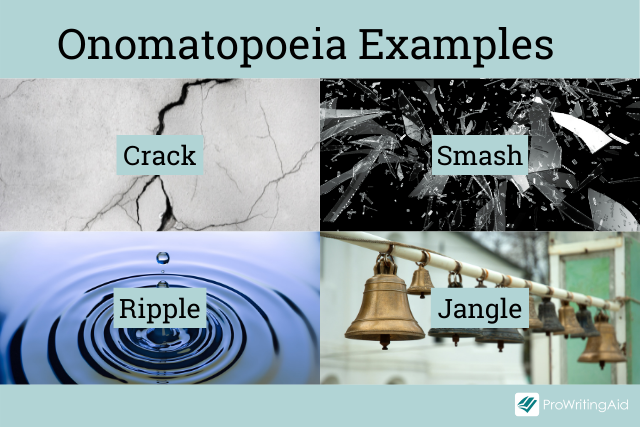
Poetic Devices of Meaning
Poets also have several poetic devices available which allow them to tease out the intended meaning of the poem without having to be too literal.
#10: Allusion
Allusion is an indirect reference to a person, place, thing, history, mythology, or work of art, that the poet wants to acknowledge as relevant to the poem’s meaning.
TS Eliot’s The Waste Land begins with an allusion (indeed the whole poem is packed with them), announcing "April is the cruellest month, breeding / Lilacs out of the dead land" which alludes to and contrasts the opening of The Canterbury Tales in which the coming of April is a joyous occasion.
#11: Conceit
Conceit is an elaborate metaphor that runs throughout the entire poem to compare two things that do not really belong together. In contrast to simple metaphors though, a conceit will be something far more fanciful and unlikely.
In To the Harbormaster by Frank O’Hara, for example, the lover is the harbormaster and the narrator a metaphysical seafarer, trying to reach his lover.
#12: Irony
Irony in poetry refers mainly to ‘dramatic irony’, in which the reader has important knowledge that the characters do not. The most famous example of this is in Romeo and Juliet, in which (spoiler alert), the audience knows Juliet isn’t dead, but can’t do anything about Romeo committing suicide.
#13: Metaphor
Metaphor is used in poetry to directly compare people, objects or ideas. Whereas similes compare using "like" or "as," metaphors declare that a thing "is" something else—he is the apple of my eye, for example—in order to to reach for a deeper understanding of the comparison.
In Hope Is the Thing with Feathers, Emily Dickinson compares hope to a bird:
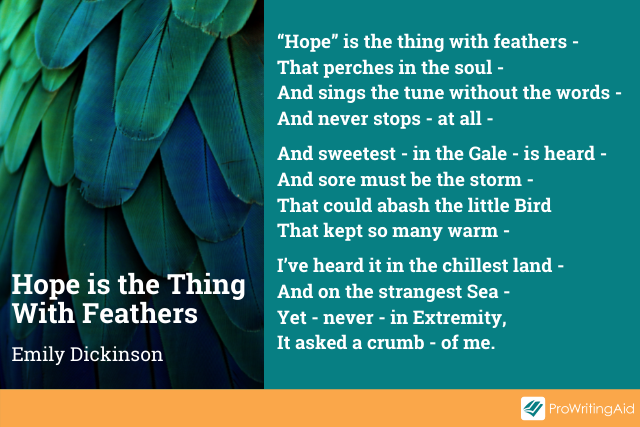
#14: Paradox
As a poetic device, paradox refers to a phrase that is self-contradictory but reveals a larger truth. In Julius Caesar, for example, Shakespeare wrote that "Cowards die many times before their deaths / The valiant never taste of death but once."
#15: Personification
Personification is when an inanimate object, animal or idea is given human characteristics; for example, "the wind whispered through the trees." Thus in Mirror, Silvia Plath writes from the perspective of the mirror:
I am silver and exact. I have no preconceptions.
Whatever I see I swallow immediately.
#16: Rhetorical Question
In poetry and literature, a rhetorical question is a question that is not looking for an answer, rather is being asked to make a point. In the poem cited earlier, Ode to the West Wind, Shelley asks in the final line:
O Wind,
If Winter comes, can Spring be far behind?
#17: Simile
The simile, like the metaphor, offers another device for comparison. However, a simile is much more blatant and uses like or as to draw the comparison. Robert Frost uses simile in his poem Design:
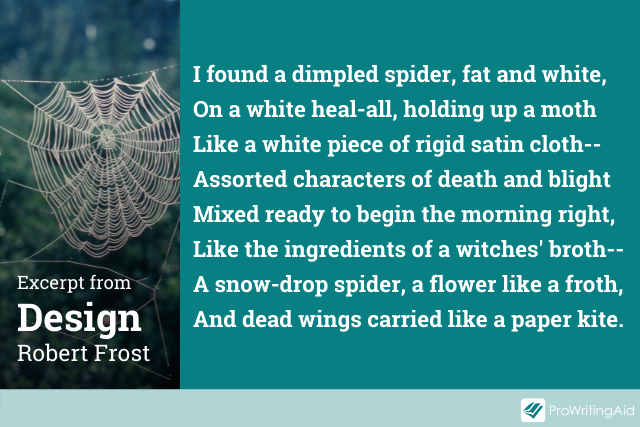
#18: Symbolism
Poets use symbolism to convey hidden meanings. Places, objects, and actions can all be symbols, with many layers of meaning tied to them. Symbolism adds depth to the literal meaning of the poem.
Thus, in The Pasture, by Robert Frost, "to clean the pasture spring" is to push sin away and "wait to watch the water clear" is to wait until the heart is sin-free:
I’m going out to clean the pasture spring;
I’ll only stop to rake the leaves away
(And wait to watch the water clear, I may):
I sha’n’t be gone long.—You come too.The Pasture—Robert Frost
Poetic Devices of Rhythm
Devices of rhythm are those that give the poem a rhythmic effect and in doing so allow the poet to stress certain elements of meaning and emotion.
#19: Caesura
Caesura means a break or pause in the verse to allow one phrase to finish and another to begin. This can be used both to allow a natural flow to the poem, or alternatively, to add dramatic pauses, show contrast and create drama and tension.
For example, Emily Dickinson’s poem I’m Nobody! Who Are You? uses caesura in the following places:
I’m nobody! || Who are you?
Are you nobody too?
Then there’s a pair of us || Don’t tell!
They’d banish us, || – you know!
#20: Enjambment
Enjambment is the continuation of a phrase or sentence beyond the poetic line break and sometimes beyond the couplet or stanza, without the pause that you would expect from a full stop or other punctuation.
It encourages the reader to keep reading, whilst controlling the rhythm and flow of their reading. This is best exemplified in Between Walls by William Carlos Williams, in which the whole poem consists of a single sentence split into 10 enjambed lines:
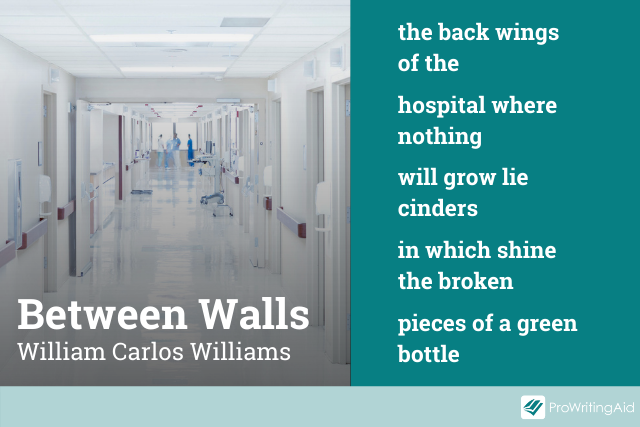
#21: Meter
Meter is the rhythm of the poem itself, measured in the length and number of ‘feet’ in each line. The most widely recognized of these is the iambic pentameter—which we discussed in the section on sonnet—a form that replicates and amplifies the rhythm of natural speech and gives a regular, heartbeat like feel to the verse.
The pattern of iambic pentameter—five feet, each containing a stressed and unstressed syllable—goes like this:
Shall I |comp ARE |thee TO | a SUM| mers DAY?
As well as the iamb, other meters include the anapest (unstressed, unstressed, stressed), the trochee (stressed, unstressed) and the dactyl (stressed, unstressed, unstressed).
#22: Rhyme
Rhyme is the most obvious of poetic devices, using repeating patterns of similar sounds, to create musicality and rhythm and give the poem symmetry. One of the most common rhymes is the couplet, which is two lines that rhyme together.
The following example is a simple two-line poem called The Cow by Ogden Nash:
The cow is of the bovine ilk;
One end is moo, the other, milk.
Whilst this end rhyme form is the most well-known, many poets also utilize internal rhymes. So, in The Rime of the Ancient Mariner, Coleridge writes:
In mist or cloud, on mast or shroud
Whiles all the night through fog-smoke white
#23: Repetition
The repetition of certain words or phrases is a method of indirectly stressing emotions or ideas and reinforcing the central point of the poem. Repetition can be used with words, phrases, lines, and even full verses.
One of the most famous poems of the 20th century, Do Not Go Gentle Into That Good Night by Dylan Thomas, repeats two lines throughout the poem. Here it is within ProWritingAid’s Echoes report
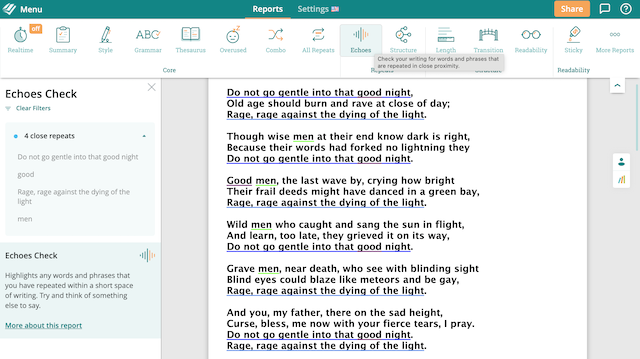
Poetic Devices—Punctuation
Whereas in normal writing, punctuation has a utilitarian purpose, in poetry it can be used as a tool of expression or artistic choice.
#24: Apostrophe
In poetry, the term apostrophe doesn't refer to the same type of punctuation as you would expect, rather it is a poetic device to show that the speaker is addressing someone who is not present in the poem.
Apostrophe is usually invoked using the letter O as a punctuation mark, indicating someone is being addressed. Thus in To Morning, Blake addresses the morning star, as the huntress Diana:
O holy virgin! clad in purest white,
Unlock heav’n’s golden gates, and issue forth.
#25: Comma
In poetry, commas show a pause and a separation of elements as well as allowing you to remove "and" from a line. In In Memoriam A. H. H. OBIIT MDCCCXXXIII Tennyson uses commas in multiple ways:
Ring out, wild bells, to the wild sky,
The flying cloud, the frosty light:
The year is dying in the night;
Ring out, wild bells, and let him die.
#26: Exclamation Mark
Poets use exclamation marks to express exhilaration, excitement, joy, surprise, or to add emphasis.
As an example, Emily Dickinson’s use of exclamation marks, along with dashes, was essential to her style—that of a young, energetic poet, brimming with life:

#27: Question Mark
As discussed in the section on rhetorical questions above, question marks are often used by poets to suggest a brief contemplative moment in the poem to consider the question being posed.
How to Identify Poetic Devices
In this article we have looked at the main types and examples of literary devices in poetry, but there are hundreds more we couldn’t cover, such as anaphora, epistrophe, litotes, and zeugma, to name but a few. As with all things, the more poetry that you read (and write) and the more you take an interest, the quicker you will recognize the creative use of poetic devices. Continually ask yourself, "what are the poetic devices in the poem I am reading?"
Then, as you begin to use them in your own poetry, the first and most important lesson is- don’t overuse them. Less is often more with poetry, so avoid alliterative odes to mum’s favorite vase, full of symbolism and packed with caesura and exclamation marks!
If you’re unsure that you’re getting the balance right, you can use the Alliteration Report (or the Clichés and Redundancies Report) in ProWritingAid to keep your poetry natural and free flowing.


